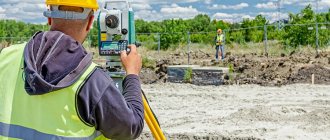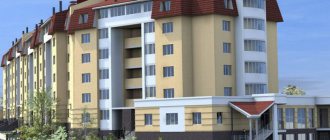Land that is acquired as a property or lease can only be used for its intended purpose. The Land Code of the Russian Federation (Article 7) distinguishes seven different categories of land: agricultural, populated areas, industrial, specially protected, forest and water resources, reserves. Within each category, its own types of use are permitted:
- Thus, agricultural land is used for gardening, vegetable gardening, farming, animal husbandry, beekeeping, fish farming, etc.;
- lands of industrial significance - for the construction of industrial, energy, transport, space and defense facilities, information communications, television and radio broadcasting, etc.
But often we have to deal with such a concept as “individual housing construction land”. What it is?
What is individual housing construction: decoding and legislative framework
The abbreviation IZhS literally means: individual residential construction.
What does individual housing construction mean in the Civil Code of the Russian Federation?
The Town Planning Code defines as an individual housing construction object a separate private household for one family (a residential building, outbuildings, attics and other household plots) within the land plot allocated for construction. A residential building must have a maximum of three floors.
How is individual housing construction deciphered in the Code of Rules?
SP 30–102-99 gives its definition:
Individual housing construction is a way of providing citizens with their own housing through individual construction. At the same time, citizens either participate in construction themselves, or it is carried out at their expense.
What land is intended for individual housing construction?
Individual residential construction is permitted on the lands of populated areas (cities, towns and villages).
- On lands of agricultural significance, it is possible to build structures and facilities necessary for growing, processing and storing agricultural products, keeping animals, working equipment, implements, etc.
- Residential buildings on agricultural lands are also built on dacha, garden and vegetable plots, but these are non-permanent buildings intended for recreation and seasonal stay. If they can still be registered as property, for example, under the dacha amnesty, then you cannot register in them.
- Another option to obtain land for individual housing construction on land not intended for this purpose is to transfer the land from the old category to a new one - “for settlement”: this can be done, for example, if the land plot is located at a distance of no more than 30 km from the city, and the site is located outside boundaries of a public easement.
Do I need to obtain a permit for individual residential construction?
Initially in the Civil Code of the Russian Federation in Art. 51 Part 9 establishes the following regulations for obtaining permits for construction, repair or reconstruction of individual housing construction projects:
- Application from an individual developer with a request to authorize construction to the authorized executive bodies (RF, constituent entities of the Russian Federation, local self-government bodies*).
- Title documents for land.
- Urban development plan *, made no later than three years ago before submitting an application for development.
- Layout of the land plot indicating the individual housing construction object on it.
- Description of the appearance of the residential housing construction* (building materials used, color design, architectural features, graphic description), if construction will be carried out within the boundaries of federal or regional historical settlements (except for the cases specified in clause 10.2 of Article 51 of the Civil Code of the Russian Federation).
According to clause 9.1 of Art. 51 developers may not provide title documents and urban planning plans, since authorized bodies request them from the relevant federal, regional, local authorities or subordinate organizations - where these documents are located.
Permission for individual housing construction is issued for a period of 10 years.
*Note:
- Local self-government bodies are local self-government bodies.
- ZU - land plot.
- OIZHS is an object of individual residential construction.
In 2020, it is not necessary to obtain permission for individual housing construction
In August 2020, Federal Law No. 372 simplified individual construction by amending the town planning code. This means that now there is no need to obtain permission for individual housing construction, but you just need to notify the authorized executive bodies about the planned construction. The innovation is based on the fact that the owner has the right to use the land within the limits of its intended purpose at his own discretion. And one of the purposes of land for settlement is individual housing construction.
Applying to the authorized bodies with a request to give permission to build a residential building is necessary only if the land plot is located on lands of other categories. In this case, it is necessary to apply for the transfer of land to the category of “land of a populated area”.
Why are plots in DNP and SNT cheaper than individual housing construction?
First, let's define the concepts and differences between these types of lands.
DNP is a dacha non-profit association of all land owners. It is subject to state registration, and land for it is allocated by the local government administration.
There are two types of DNP lands: those located within the boundaries of a populated area and agricultural lands. Moreover, 3 years are given to develop the land after the creation of the partnership.
Most Garden Non-Profit Partnerships ( SNT ) are a “cut” of small plots ranging in size from 4 to 6 acres, on which farming and construction were carried out in the last century.
DNP is a more modern form of association. The area of their plots is, as a rule, 10-15 acres.
What is an individual residential building?
An individual residential building must comply with codes of practice 55.13330.2011, sanitary design standards SNiP and urban planning regulations.
Minimum requirements for the number of premises for a residential building:
- one living room;
- room for a kitchen or dining room;
- bath or shower;
- toilet;
- pantry or built-in wardrobes;
- boiler room with a heat generator (in the absence of central heating).
The house must have water and heat supply, electricity, sewerage, and ventilation.
Room dimensions and ceiling height:
Minimum distance of the landfill from the borders of other territories (red lines):
- streets - 5 m;
- driveways - 3 m;
- other sections of individual housing construction - 3 m.
Maximum plot sizes:
- in the urban area - 0.1 ha;
- PGT (urban-type settlements) - 0.15 hectares;
- rural areas - 0.25 hectares.
Requirements for load-bearing structures of houses and foundations
- Load-bearing structures must withstand the standard load. If the site is located in a seismic or landslide zone, the requirements become more stringent and are regulated by relevant rules.
- The foundation is designed in accordance with the characteristics of the soil, hydrogeological regime, and the presence of groundwater.
Fire safety requirements for residential buildings
Individual residential buildings must be built in accordance with the regulations on fire safety requirements (hazard class F.1).
- The distance between residential buildings must be maintained in accordance with the above regulations.
- Adjacent blocks must be separated by fire-resistant walls (fire resistance not less than REI 45).
- The structures of 3-story houses must have a third degree of fire resistance (for houses no more than 150 m2, a fourth degree of fire resistance is allowed). Houses must be equipped with optical fire detectors.
- Separate emergency exits must be provided from residential blocks.
- In the absence of central heating, it is allowed to use only factory-made gas or liquid fuel heat generators installed in premises that comply with standard safety standards SP 61.13330, SP 62.13330.
- Gas cylinder installations can only be installed outside the house. It is allowed to use a gas cylinder with a volume of no more than 50 liters indoors.
- Gas fireplaces should also only be factory-made.
- Installation of electrical equipment must be carried out using residual current devices (RCDs).
- Fire insulated cable or wires must be used for electrical wiring.
Sanitary and epidemiological requirements
In permanent premises the air temperature should be at least 20, in the kitchen and toilet - 18, in the bathroom - 24.
- The ventilation system for air purification is natural (windows, windows), mechanical and combined.
- Contaminated air is removed through ventilation ducts. Ventilation capacity: living rooms - one volume of air per hour;
- kitchen - 60 m3/hour;
- toilet - 25 m3/hour;
- other rooms, as well as in non-working mode - 0.2 volume/hour.
Construction project and passport of the individual housing construction project
The preparation of design documentation for the construction/reconstruction of residential housing construction, on the basis of Article 48 of the Civil Code of the Russian Federation, can be carried out by the developer himself (in other cases, this is done by design organizations at the request of the developer). State examination of such documentation is not carried out (Article 49 of the Civil Code).
The project includes:
- situational, topographical, general plans (with reference to the area);
- floor plans: sectional drawings of the house;
- basement, roof, foundation plans;
- documents on the estimate;
- engineering calculations;
- project passport.
A complete list of project documentation is in Appendix 8 SP 11–111-99.
The passport form and the list of materials included in it are in Appendix 7 SP 11–111-99.
Registration of individual housing construction object
To register an individual housing estate, you need to submit the following documents to the Unified State Register of Real Estate:
- cadastral passport of the land plot (to be ordered from the BTI);
- title documents for the land plot (purchase and sale agreement, transfer of ownership, etc.).
Notification procedure for individual housing construction
Since August 4, 2020, individual housing construction has completely switched to a notification procedure. You no longer need to obtain permission to build a residential or garden house on your site, but construction work is prohibited from starting without prior notification of the authorized body. It will also be impossible to move into the finished house immediately upon completion of the work - first you will need to send another notification, attaching a number of documents to it. It would seem that the notification procedure is a mere formality and should simplify the procedure with control authorities, but in reality this notification will require no less hassle and is in fact an analogue of the previous construction permit. Let us explain the details of the new provisions of the legislation.
Federal Law No. 340-FZ “On Amendments to the Town Planning Code of the Russian Federation and Certain Legislative Acts of the Russian Federation,” which entered into force on August 3, 2020, introduces significant changes to the construction procedure. In this article we will consider only one of them - the transition to a notification procedure when constructing a residential or garden house on a land plot with permitted use for individual housing construction or for running a personal subsidiary plot. It affects every owner of a plot who intends to build a residential or garden house on their land, or to reconstruct an existing old, dilapidated building that has fallen into disrepair.
The purpose of the amendments to the Town Planning Code in this part is an attempt to streamline the construction and reconstruction of individual housing construction projects and garden houses. However, these provisions of the law do not apply to non-residential buildings, such as outbuildings, bathhouses, and the like.
The essence of the innovations: before the start of construction work (construction of a new house or reconstruction of an existing building), it is necessary to notify higher authorities about this, and when the house is ready, send a notification that the work has been completed. However, the simplification of the system is not obvious here. In fact, such a notification requires the collection of a significant package of documents and corresponds to obtaining a permit. All provided documents will be carefully checked, compliance with all norms and standards will be monitored, and only after that you will be allowed to begin work. But if it is revealed that the documentation does not correspond to the real state of affairs, officials have the right not to approve the construction either at the first stage or at the final stage, when the owner sends a notification again - this time about the completion of the work. And the house you built with such efforts may, as a result, be considered an unauthorized construction. But let's deal with everything in order.
WE START BUILDING A HOUSE
So, as Rosreestr reports, previously, in order to register the state cadastral register and register property rights, a citizen with rights to a land plot had to draw up technical documentation for the newly created real estate property, pay the state fee and submit the appropriate application to the registration authority through the MFC.
From August 4, 2020, in order to start building a residential building on their land, the owner of the land plot is obliged to notify the architectural authorities in advance, attaching the necessary documents to the notification. Thus, the developer must draw up a paper document in the prescribed form (which can be downloaded on the website kadastr.ru). The notification shall indicate the surname, name and patronymic of the person who began construction work (or the name of the developer), address of residence or registration, cadastral number of the site and other information required by law. This document must be accompanied by a whole package of papers, including, first of all, documents confirming ownership of the land plot, as well as papers such as a description of the external appearance of the house and its graphic and schematic representation. However, in some cases such a description will not be required. We are talking about building a house on the territory of a historical settlement according to the same type that all homeowners living in this area build their homes. A typical house does not need a description of the details, says the law.
When the package of documents collected by the owner reaches the authorized body, it undergoes a number of checks: all specified information is carefully checked to ensure compliance with the maximum construction parameters, type of land use, and compliance of the future construction with all legal norms. After a detailed study of the documentation, the applicant receives a response notification that his planned construction is considered legal. Only after this can he begin work.
AFTER COMPLETION OF CONSTRUCTION
If the procedure for submitting notifications, even if compared to obtaining a construction permit, does not make life easier for the owner of a land plot, but at least does not make it more difficult, then the introduction of an additional mandatory notification about the completion of construction work is an innovation that is unlikely to please. Let us remind you that previously the so-called dacha amnesty made it possible to put a residential building into operation without asking for permission. Now it is impossible to move into the house until the regulatory authorities check the compliance of the completed work with all the norms and requirements of the law.
To do this, as soon as all work on the construction of the house is completed, the owner is obliged to draw up another notice of completion of construction (or reconstruction). Such a document must again indicate the details of the owner and construction company, the cadastral number of the land plot on which the residential building was erected, a receipt for payment of the state duty, as well as a number of parameters of the erected building. The package of documents attached to the notification includes a technical plan for the construction, a power of attorney from the representative (if the notification is not submitted by the owner himself), and an agreement between the co-owners of the site on the amount of shares in the ownership of the house if it is owned by two or more people.
If the submitted package of documents is incomplete, it will not be accepted and will be returned for revision. If the submitted documentation is successfully processed, officials begin inspecting the completed building to check whether the information provided by the owner in the notice corresponds to the real state of affairs. The legislation allows 7 working days for document verification and inspection. Based on the results of a comprehensive inspection, a notification is drawn up about the compliance or non-compliance of the built house with the requirements and legislative norms and is sent to the address of the owner of the land plot.
IF NOT NOTIFIED
It is worth considering that this notification procedure is mandatory. If a notice of completion of construction has not been submitted, the registering authority has the right to suspend state registration of the right to this property. In turn, failure to eliminate the reason preventing the implementation of state cadastral registration and (or) state registration of rights will entail a refusal to provide the declared public service, in accordance with Article 27 of the Registration Law.
Thus, the owner who has built a residential or garden house on his plot will not be able to register ownership rights to it; this property will not be in the Unified State Register database, which means it will be impossible to dispose of it and make any transactions with it in the future.
However, to ensure that the jump to the new system is not so sudden and that the owners have time to familiarize themselves with the innovations, a transition period is provided: until March 1, 2019, the owner of the site can obtain such permission even after he has begun work on building a house. But starting from March 1, the decision on the commissioning or demolition of a building will be made only in court, registering services warn.
From March 1, 2020, the difference between building a house on plots for different purposes will also be eliminated. As already mentioned, before building or reconstructing either a residential or garden house, a citizen will be required to send a notification to the local government about the start of construction. If the characteristics of the house being built change, he will also have to send a notification in the appropriate form. The third notice is sent upon completion of construction work.








